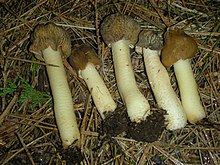
Edible mushrooms are the fleshy fruit bodies of several species of macrofungi. Edibility may be defined by criteria including the absence of poisonous effects on humans and desirable taste and aroma. Mushrooms that have a particularly desirable taste are described as "choice". Edible mushrooms are consumed for their nutritional and culinary value. Mushrooms, especially dried shiitake, are sources of umami flavor.

Morchella, the true morels, is a genus of edible sac fungi closely related to anatomically simpler cup fungi in the order Pezizales. These distinctive fungi have a honeycomb appearance due to the network of ridges with pits composing their caps. Morels are prized by gourmet cooks, particularly in Catalan and French cuisine, but can be toxic if consumed raw or undercooked. Due to difficulties in cultivation, commercial harvesting of wild morels has become a multimillion-dollar industry in the temperate Northern Hemisphere, in particular North America, Turkey, China, the Himalayas, India, and Pakistan where these highly prized fungi are found in abundance.

Morchella esculenta is a species of fungus in the family Morchellaceae of the Ascomycota. It is one of the most readily recognized of all the edible mushrooms and highly sought after. Each fruit body begins as a tightly compressed, grayish sponge with lighter ridges, and expands to form a large yellowish sponge with large pits and ridges raised on a large white stem. The pitted yellow-brown caps measure 2–7 centimetres broad by 2–10 cm (1–4 in) tall, and are fused to the stem at its lower margin, forming a continuous hollow. The pits are rounded and irregularly arranged. The hollow stem is typically 2–9 cm long by 2–5 cm (1–2 in) thick, and white to yellow. The fungus fruits under hardwoods and conifers during a short period in the spring, depending on the weather, and is also associated with old orchards, woods and disturbed grounds.

The name false morel is given to several species of mushroom which bear a resemblance to the highly regarded true morels of the genus Morchella. Like Morchella, false morels are members of the Pezizales, but within that group represent several unrelated taxa scattered through the families Morchellaceae, Discinaceae, and Helvellaceae, with the epithet "false morel" most often ascribed to members of the genus Gyromitra.

Paragyromitra infula, commonly known as the hooded false morel or the elfin saddle, is a species of fungus in the family Discinaceae. The dark reddish-brown caps of the fruit bodies develop a characteristic saddle-shape in maturity, and the ends of both saddle lobes are drawn out to sharp tips that project above the level of the fruit body. The stipe is white or flushed pale brown, smooth on the outside, but hollow with some chambers inside.

Gyromitra caroliniana, known commonly as the Carolina false morel or big red, is an ascomycete fungus of the genus Gyromitra, within the Pezizales group of fungi. It is found in hardwood forests of the southeastern United States, where it fruits in early spring soon after snowmelt.
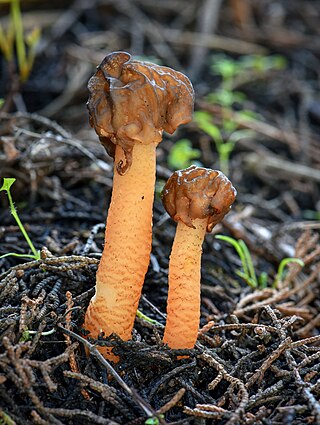
Verpa is a genus of ascomycete fungi related to the morels. Resembling the latter genus in edibility and form, the common name early morels is popular. There are five species in the widespread genus.

The Morchellaceae are a family of ascomycete fungi in the order Pezizales. According to a standard reference work, the family has contained at least 49 species distributed among four genera. However, in 2012, five genera that produce ascoma that are sequestrate and hypogeous were added. The best-known members are the highly regarded and commercially picked true morels of the genus Morchella, the thimble morels of the genus Verpa, and a genus of cup-shaped fungi Disciotis. The remaining four genera produce the sequestrate fruit bodies.

Verpa bohemica is a species of fungus in the family Morchellaceae. The synonym Ptychoverpa bohemica is often used by European mycologists and it is commonly known as the early morel or the wrinkled thimble-cap. The mushroom has a pale yellow or brown thimble-shaped cap—2 to 4 cm in diameter by 2 to 5 cm long—that has a surface wrinkled and ribbed with brain-like convolutions. A feature distinguishing the species from true morels, the cap hangs free from the top of the stem, which is lighter in color, brittle, and up to 12 cm long by 1 to 2.5 cm thick. Microscopically, the mushroom is distinguished by its large spores, typically 60–80 by 15–18 μm, and the presence of only two spores per ascus.
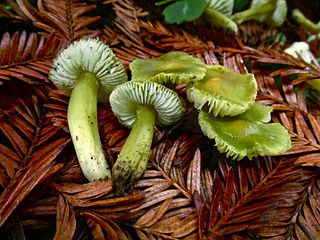
Hygrocybe virescens, commonly known as the lime-green waxy cap, is a species of agaric mushroom in the family Hygrophoraceae. The lime-green colored mushroom has a limited geographical distribution, having been reported only from California, Washington, and Mexico.
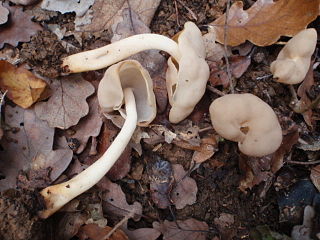
Helvella elastica, commonly known as the flexible Helvella or the elastic saddle, is a species of fungus in the family Helvellaceae of the order Pezizales. It is found in Asia, Europe, and North America. It has a roughly saddle-shaped yellow-brown cap atop a whitish stipe, and grows on soil in woods. Another colloquial name is the brown elfin saddle.

Suillus brevipes is a species of fungus in the family Suillaceae. First described by American mycologists in the late 19th century, it is commonly known as the stubby-stalk or the short-stemmed slippery Jack. The fruit bodies (mushrooms) produced by the fungus are characterized by a chocolate to reddish-brown cap covered with a sticky layer of slime, and a short whitish stipe that has neither a partial veil nor prominent, colored glandular dots. The cap can reach a diameter of about 10 cm, while the stipe is up to 6 cm long and 2 cm thick. Like other bolete mushrooms, S. brevipes produces spores in a vertically arranged layer of spongy tubes with openings that form a layer of small yellowish pores on the underside of the cap.

Hygrophorus subalpinus, commonly known as the subalpine waxycap, is a species of white snowbank fungus in the family Hygrophoraceae. Found in the mountains of western North America, it is found growing on the ground under conifers, usually near snowbanks.

Morchella rufobrunnea, commonly known as the blushing morel, is a species of ascomycete fungus in the family Morchellaceae. A choice edible species, the fungus was described as new to science in 1998 by mycologists Gastón Guzmán and Fidel Tapia from collections made in Veracruz, Mexico. Its distribution was later revealed to be far more widespread after several DNA studies suggested that it is also present in the West Coast of the United States, Israel, Australia, Cyprus, Malta and Switzerland.
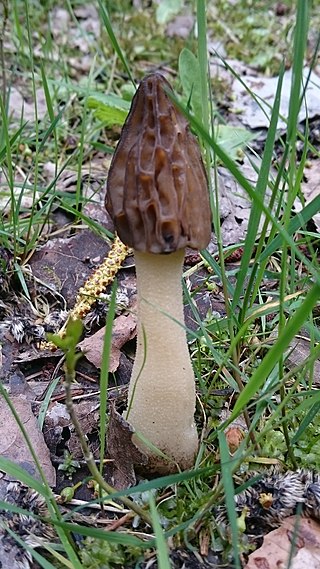
Morchella semilibera, commonly called the half-free morel, is an edible species of fungus in the family Morchellaceae native to Europe and Asia.

Morchella importuna is a species of fungus in the family Morchellaceae described from North America in 2012. It occurs in gardens, woodchip beds, and other urban settings of northern California and the Pacific Northwest region of the United States and Canada. The fungus has also been reported from Turkey, Spain, France, Switzerland, Canada and China, although it is unknown whether this is a result of accidental introductions. It is considered a choice edible mushroom. The fruit bodies develop a distinctive ladder-like pattern of pits and ridges on the surface of their conical caps.

Morchella populiphila is a species of morel fungus native to northwestern North America. Described as new to science in 2012, its specific epithet refers to its association with black cottonwood. The morel used to be referred to as Morchella semilibera in western North American field guides until molecular analysis established that to be a strictly European species. M. populiphila occurs in California, Nevada and Oregon. Its fruit bodies grow up to 15 cm (6 in) tall with a ridged and pitted conical cap that attaches about halfway down the stipe. The cap ridges are dark brown to black in maturity, while the pits are yellowish to brownish. The fungus is edible, although not as highly valued as other morels.

Morchella punctipes is a species of morel fungus in the family Morchellaceae. It is native to North America, found widely distributed east of the Rocky Mountains. It is edible when cooked.

Picipes badius, commonly known as the black-footed polypore or black-leg, is a species of fungus in the family Polyporaceae. It causes a white rot of hardwoods and conifers. The species is found in temperate areas of Asia, Australia, Europe, and North America. It has a dark brown or reddish-brown cap that reaches a diameter of 25 cm (9.8 in), and a stipe that is often completely black or brown at the top and black at the base.

Pholiota nubigena, commonly known as the gastroid pholiota or the bubble gum fungus, is a species of secotioid fungus in the family Strophariaceae. It is found in mountainous areas of the western United States, where it grows on rotting conifer wood, often fir logs. It fruits in spring, often under snow, and early summer toward the end of the snowmelt period in high mountain forests. Fruit bodies appear similar to unopened mushrooms, measuring 1–4 centimetres tall with 1–2.4 cm diameter caps that are whitish to brownish. They have a short but distinct whitish stipe that extend through the internal spore mass (gleba) of the fruit body into the cap. The gleba consists of irregular chambers made of contorted gills that are brownish in color. A whitish, cottony partial veil is present in young specimens, but it often disappears in age and does not leave a ring on the stipe.
